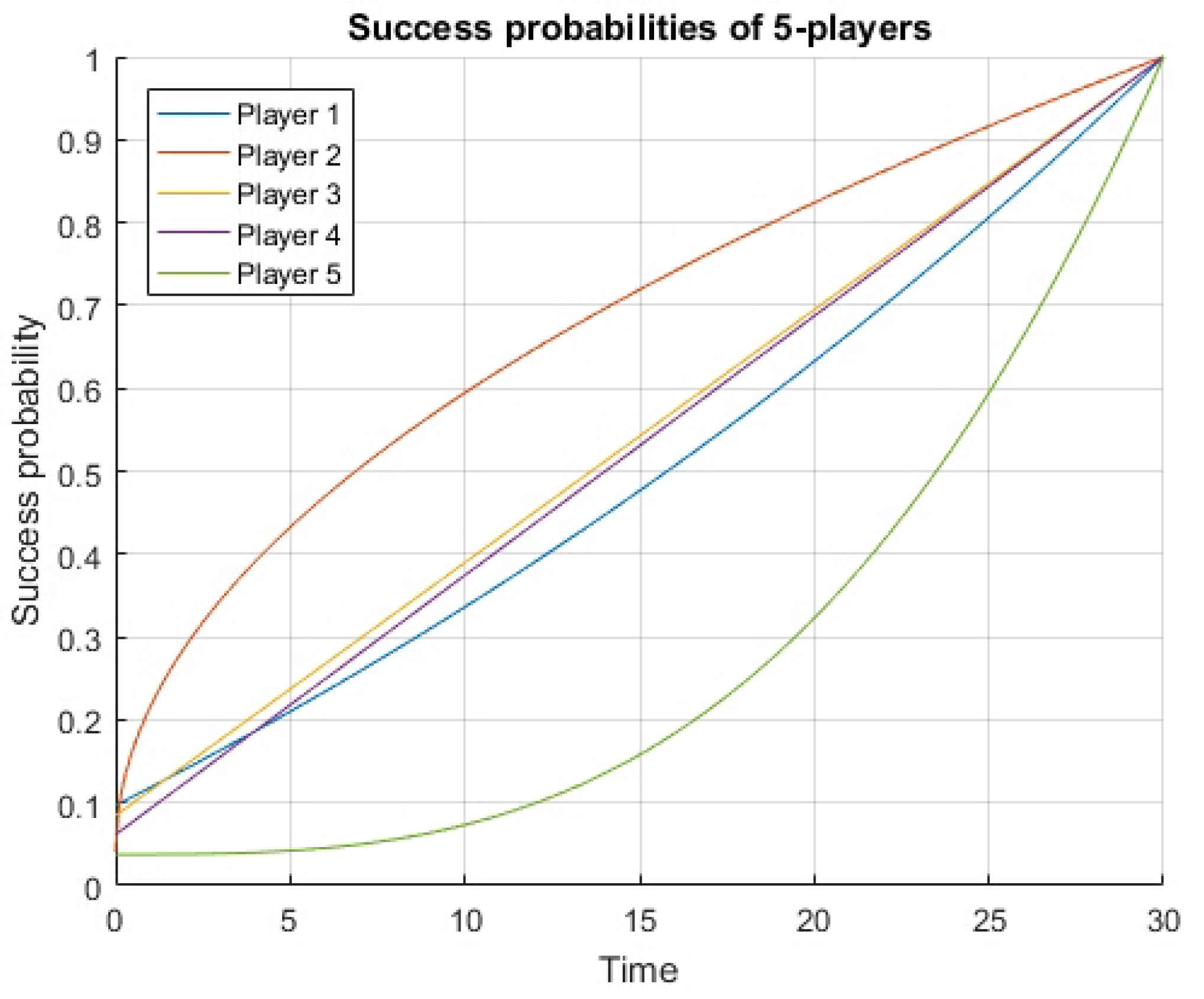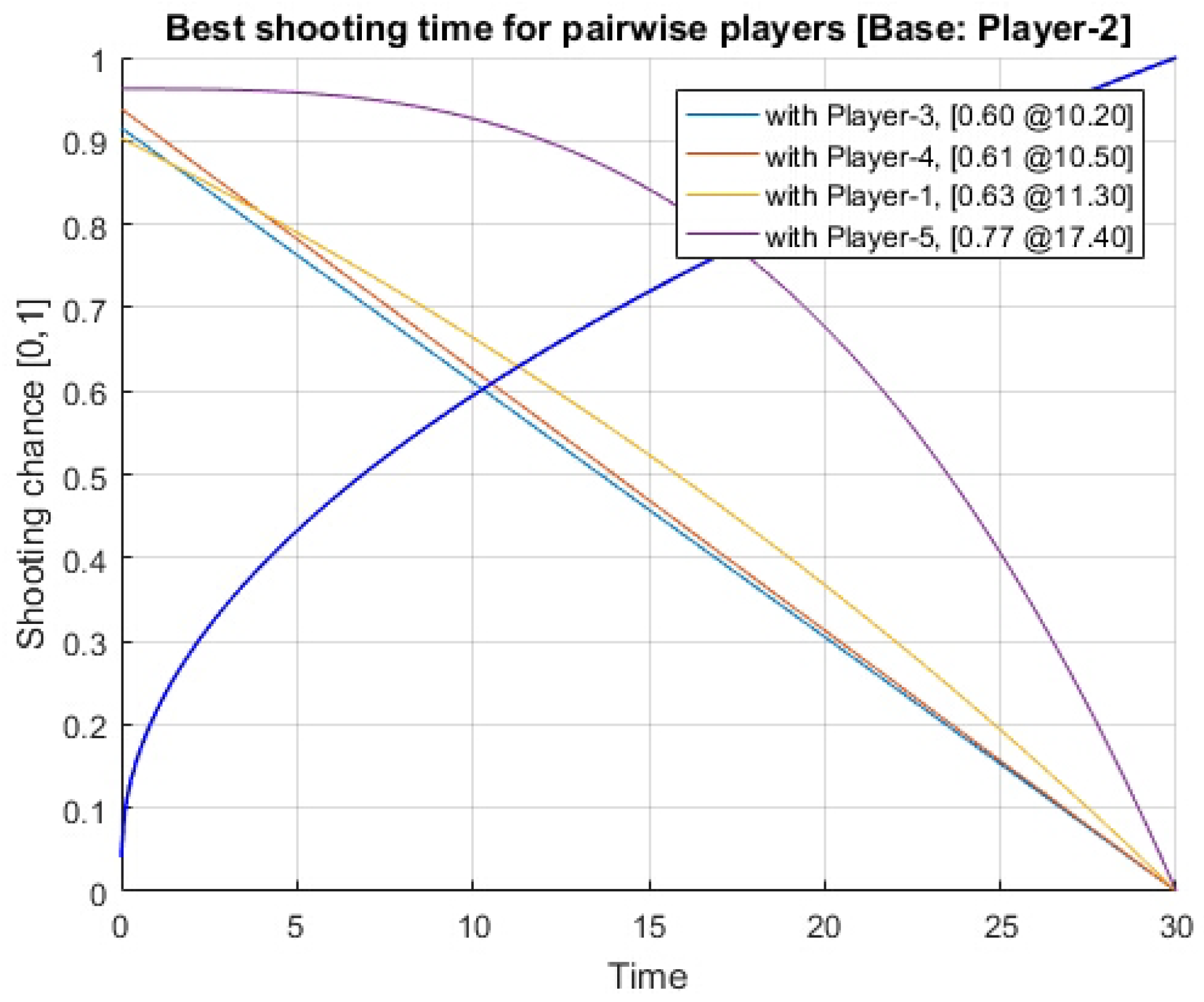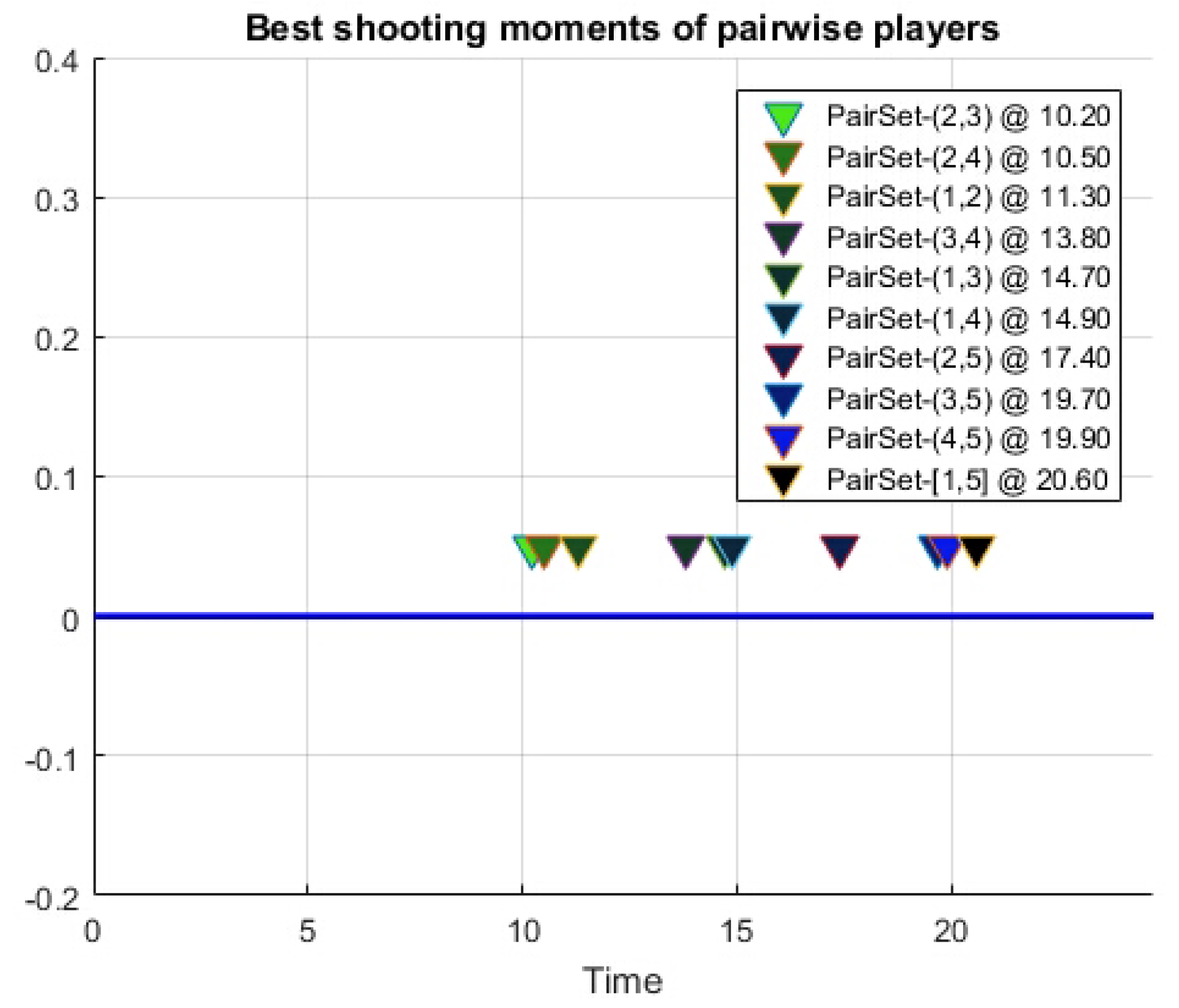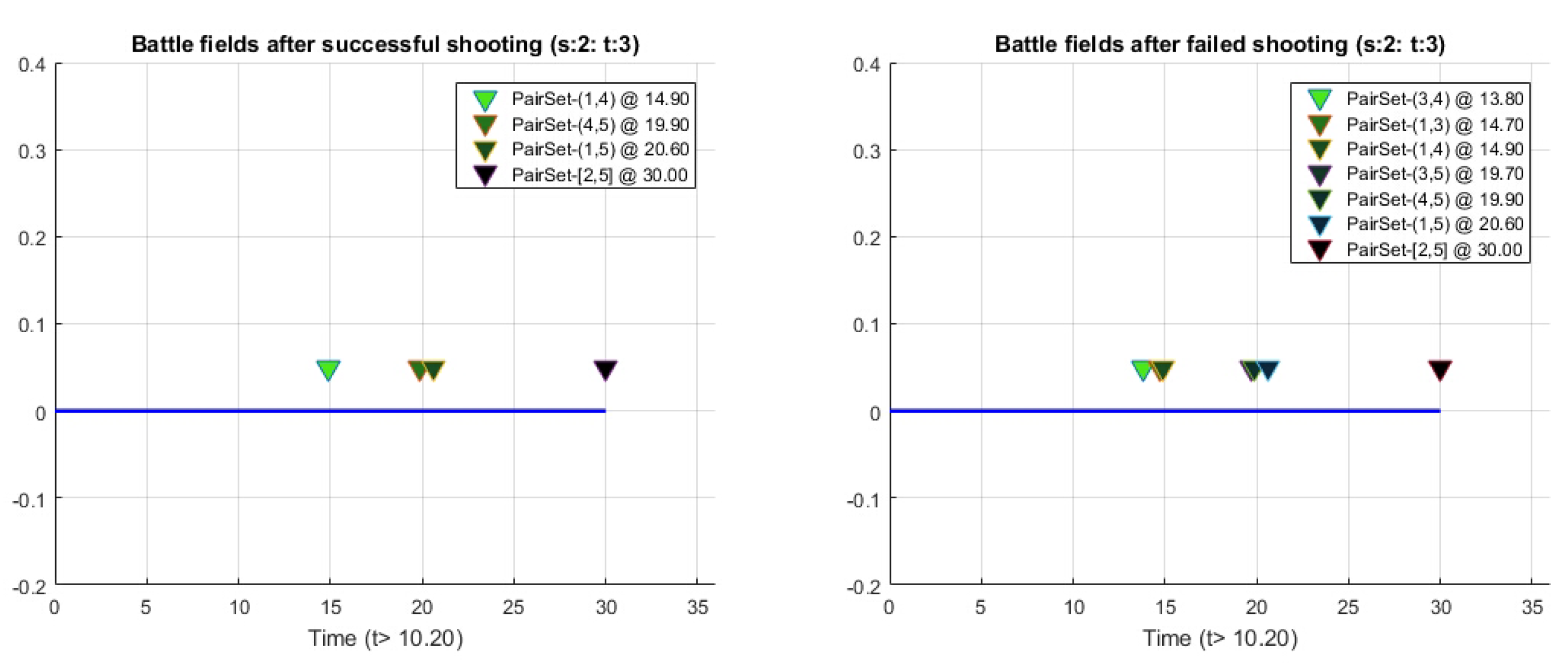Robust Pairwise n-Person Stochastic Duel Game
Abstract
1. Introduction
2. n-Person Stochastic Duel Game
2.1. Preliminaries
2.2. Pairwise Set of Shooting Orders
2.3. Status Change of Pairwise n-Person Duel Game after Shooting
- Each player has a gun with a single bullet;
- Player is the first-ordered shooter on the first battlefield;
- Each player could have two strategic choices;
- Once a shot occurs, the success probability of the shooter becomes zero;
- The game ends when all players use their bullets.
3. Optimal Strategies for an n-Person Duel Game
3.1. Finding the Best Battlefield for Shooting
3.2. Best Shooting Moment on the m-th Battlefield
- (for player i on the m-th battle field )(for player on the m-battle field )and
3.3. Numerical Case Practices
4. Conclusions
Funding
Institutional Review Board Statement
Informed Consent Statement
Data Availability Statement
Acknowledgments
Conflicts of Interest
References
- Konstantinov, R.V.; Polovinkin, E.S. Mathematical simulation of a dynamic game in the enterprise competition problem. Cybern. Syst. Anal. 2004, 40, 720–725. [Google Scholar] [CrossRef]
- Kam, S.; Wong, S.; Tong, C. The influence of market orientation on new product success. Eur. J. Innov. Manag. 2012, 15, 99–121. [Google Scholar]
- Kalish, S.; Mahajan, V.; Muller, E. Waterfall and sprinkler new-product strategies in competitive global markets. Int. J. Res. Mark. 1995, 12, 105–119. [Google Scholar] [CrossRef]
- Azzone, G.; Pozza, I.D. An integrated strategy for launching a new product in the biotech industry. Manag. Decis. 2003, 41, 832–843. [Google Scholar] [CrossRef]
- Johnson, B.; Laszka, A.; Grossklags, J.; Vasek, M.; Moore, T. Game-theoretic analysis of ddos attacks against bitcoin mining pools. In International Conference on Financial Cryptography and Data Security; Springer: Berlin, Germany, 2014; pp. 72–86. [Google Scholar]
- Laszka, A.; Johnson, B.; Grossklags, J. When bitcoin mining pools run dry. In International Conference on Financial Cryptography and Data Security; Springer: Berlin, Germany, 2015; pp. 63–77. [Google Scholar]
- Kim, S.-K.; Yeun, C.Y.; Damiani, E.; Al-Hammadi, Y.; Lo, N.W. Blockchain Adoptation For Automotive Security by Using Systematic Innovation. In Proceedings of the 2019 IEEE Transportation Electrification Conference and Expo, Asia-Pacific (ITEC Asia-Pacific), Seogwipo, Korea, 8–10 May 2019; pp. 1–4. [Google Scholar]
- Kim, S.-K. Enhanced IoV Security Network by Using Blockchain Governance Game. Mathematics 2021, 9, 109. [Google Scholar] [CrossRef]
- Polak, B. Discussion of Duel. Open Yale Courses. 2008. Available online: http://oyc.yale.edu/economics/econ-159/lecture-16 (accessed on 1 May 2019).
- Moschini, G. Nash equilibrium in strictly competitive games: Live play in soccer. Econ. Lett. 2004, 85, 365–371. [Google Scholar] [CrossRef]
- Radzik, T. Games of Timing Related to Distribution of Resources. J. Optim. Theory Appl. 1988, 58, 443–471. [Google Scholar] [CrossRef]
- Radizik, T. Silent Mixed Duels. Optimization 1989, 20, 553–556. [Google Scholar] [CrossRef]
- Lang, J.P.; Kimeldorf, G. Silent Duels with Non Discrete Firing. SIAM J. Appl. Math. 1976, 31, 9–110. [Google Scholar] [CrossRef]
- Schwalbe, U.; Walker, P. Zermelo and the Early History of Game Theory. Games Econ. Behav. 2001, 34, 123–137. [Google Scholar] [CrossRef]
- Kingston, C.G.; Wright, R.E. The deadliest of games: The institution of dueling. South. Econ. J. 2010, 76, 1094–1106. [Google Scholar] [CrossRef]
- Dshalalow, J.H.; White, R. On Reliability of Stochastic Networks. Neural Parallel Sci. Comput. 2013, 21, 141–160. [Google Scholar]
- Dshalalow, J.H.; Iwezulu, K.; White, R.T. Discrete Operational Calculus in Delayed Stochastic Games. Neural Parallel Sci. Comput. 2016, 24, 55–64. [Google Scholar]
- Kim, S.-K. A Versatile Stochastic Duel Game. Mathematics 2020, 8, 678. [Google Scholar] [CrossRef]
- Kim, S.-K. Antagonistic One-To-N Stochastic Duel Game. Mathematics 2020, 8, 1114. [Google Scholar] [CrossRef]




Publisher’s Note: MDPI stays neutral with regard to jurisdictional claims in published maps and institutional affiliations. |
© 2021 by the author. Licensee MDPI, Basel, Switzerland. This article is an open access article distributed under the terms and conditions of the Creative Commons Attribution (CC BY) license (https://creativecommons.org/licenses/by/4.0/).
Share and Cite
Kim, S.-K. Robust Pairwise n-Person Stochastic Duel Game. Mathematics 2021, 9, 825. https://doi.org/10.3390/math9080825
Kim S-K. Robust Pairwise n-Person Stochastic Duel Game. Mathematics. 2021; 9(8):825. https://doi.org/10.3390/math9080825
Chicago/Turabian StyleKim, Song-Kyoo (Amang). 2021. "Robust Pairwise n-Person Stochastic Duel Game" Mathematics 9, no. 8: 825. https://doi.org/10.3390/math9080825
APA StyleKim, S.-K. (2021). Robust Pairwise n-Person Stochastic Duel Game. Mathematics, 9(8), 825. https://doi.org/10.3390/math9080825





